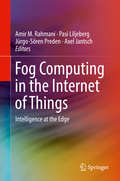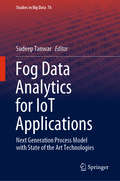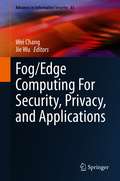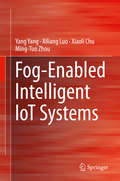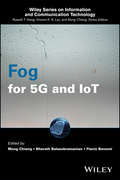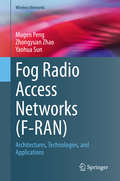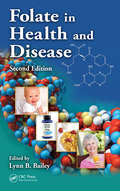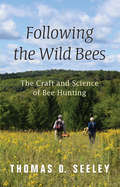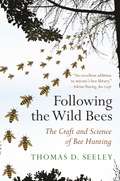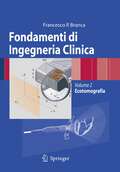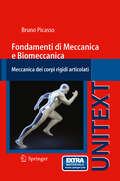- Table View
- List View
Fog Computing for Healthcare 4.0 Environments: Technical, Societal, and Future Implications (Signals and Communication Technology)
by Sudeep TanwarThis book provides an analysis of the role of fog computing, cloud computing, and Internet of Things in providing uninterrupted context-aware services as they relate to Healthcare 4.0. The book considers a three-layer patient-driven healthcare architecture for real-time data collection, processing, and transmission. It gives insight to the readers for the applicability of fog devices and gateways in Healthcare 4.0 environments for current and future applications. It also considers aspects required to manage the complexity of fog computing for Healthcare 4.0 and also develops a comprehensive taxonomy.
Fog Computing in the Internet of Things: Intelligence at the Edge
by Amir M. Rahmani Pasi Liljeberg Jürgo-Sören Preden Axel JantschThis book describes state-of-the-art approaches to Fog Computing, including the background of innovations achieved in recent years. Coverage includes various aspects of fog computing architectures for Internet of Things, driving reasons, variations and case studies. The authors discuss in detail key topics, such as meeting low latency and real-time requirements of applications, interoperability, federation and heterogeneous computing, energy efficiency and mobility, fog and cloud interplay, geo-distribution and location awareness, and case studies in healthcare and smart space applications.
Fog Data Analytics for IoT Applications: Next Generation Process Model with State of the Art Technologies (Studies in Big Data #76)
by Sudeep TanwarThis book discusses the unique nature and complexity of fog data analytics (FDA) and develops a comprehensive taxonomy abstracted into a process model. The exponential increase in sensors and smart gadgets (collectively referred as smart devices or Internet of things (IoT) devices) has generated significant amount of heterogeneous and multimodal data, known as big data. To deal with this big data, we require efficient and effective solutions, such as data mining, data analytics and reduction to be deployed at the edge of fog devices on a cloud. Current research and development efforts generally focus on big data analytics and overlook the difficulty of facilitating fog data analytics (FDA). This book presents a model that addresses various research challenges, such as accessibility, scalability, fog nodes communication, nodal collaboration, heterogeneity, reliability, and quality of service (QoS) requirements, and includes case studies demonstrating its implementation. Focusing on FDA in IoT and requirements related to Industry 4.0, it also covers all aspects required to manage the complexity of FDA for IoT applications and also develops a comprehensive taxonomy.
Fog, Edge, and Pervasive Computing in Intelligent IoT Driven Applications
by Deepak GuptaA practical guide to the design, implementation, evaluation, and deployment of emerging technologies for intelligent IoT applications With the rapid development in artificially intelligent and hybrid technologies, IoT, edge, fog-driven, and pervasive computing techniques are becoming important parts of our daily lives. This book focuses on recent advances, roles, and benefits of these technologies, describing the latest intelligent systems from a practical point of view. Fog, Edge, and Pervasive Computing in Intelligent IoT Driven Applications is also valuable for engineers and professionals trying to solve practical, economic, or technical problems. With a uniquely practical approach spanning multiple fields of interest, contributors cover theory, applications, and design methodologies for intelligent systems. These technologies are rapidly transforming engineering, industry, and agriculture by enabling real-time processing of data via computational, resource-oriented metaheuristics and machine learning algorithms. As edge/fog computing and associated technologies are implemented far and wide, we are now able to solve previously intractable problems. With chapters contributed by experts in the field, this book: Describes Machine Learning frameworks and algorithms for edge, fog, and pervasive computing Considers probabilistic storage systems and proven optimization techniques for intelligent IoT Covers 5G edge network slicing and virtual network systems that utilize new networking capacity Explores resource provisioning and bandwidth allocation for edge, fog, and pervasive mobile applications Presents emerging applications of intelligent IoT, including smart farming, factory automation, marketing automation, medical diagnosis, and more Researchers, graduate students, and practitioners working in the intelligent systems domain will appreciate this book’s practical orientation and comprehensive coverage. Intelligent IoT is revolutionizing every industry and field today, and Fog, Edge, and Pervasive Computing in Intelligent IoT Driven Applications provides the background, orientation, and inspiration needed to begin.
Fog, Edge, and Pervasive Computing in Intelligent IoT Driven Applications
by Deepak Gupta Aditya KhampariaA practical guide to the design, implementation, evaluation, and deployment of emerging technologies for intelligent IoT applications With the rapid development in artificially intelligent and hybrid technologies, IoT, edge, fog-driven, and pervasive computing techniques are becoming important parts of our daily lives. This book focuses on recent advances, roles, and benefits of these technologies, describing the latest intelligent systems from a practical point of view. Fog, Edge, and Pervasive Computing in Intelligent IoT Driven Applications is also valuable for engineers and professionals trying to solve practical, economic, or technical problems. With a uniquely practical approach spanning multiple fields of interest, contributors cover theory, applications, and design methodologies for intelligent systems. These technologies are rapidly transforming engineering, industry, and agriculture by enabling real-time processing of data via computational, resource-oriented metaheuristics and machine learning algorithms. As edge/fog computing and associated technologies are implemented far and wide, we are now able to solve previously intractable problems. With chapters contributed by experts in the field, this book: Describes Machine Learning frameworks and algorithms for edge, fog, and pervasive computing Considers probabilistic storage systems and proven optimization techniques for intelligent IoT Covers 5G edge network slicing and virtual network systems that utilize new networking capacity Explores resource provisioning and bandwidth allocation for edge, fog, and pervasive mobile applications Presents emerging applications of intelligent IoT, including smart farming, factory automation, marketing automation, medical diagnosis, and more Researchers, graduate students, and practitioners working in the intelligent systems domain will appreciate this book’s practical orientation and comprehensive coverage. Intelligent IoT is revolutionizing every industry and field today, and Fog, Edge, and Pervasive Computing in Intelligent IoT Driven Applications provides the background, orientation, and inspiration needed to begin.
Fog/Edge Computing For Security, Privacy, and Applications (Advances in Information Security #83)
by Wei Chang Jie WuThis book provides the state-of-the-art development on security and privacy for fog/edge computing, together with their system architectural support and applications. This book is organized into five parts with a total of 15 chapters. Each area corresponds to an important snapshot. The first part of this book presents an overview of fog/edge computing, focusing on its relationship with cloud technology and the future with the use of 5G communication. Several applications of edge computing are discussed. The second part of this book considers several security issues in fog/edge computing, including the secure storage and search services, collaborative intrusion detection method on IoT-fog computing, and the feasibility of deploying Byzantine agreement protocols in untrusted environments. The third part of this book studies the privacy issues in fog/edge computing. It first investigates the unique privacy challenges in fog/edge computing, and then discusses a privacy-preserving framework for the edge-based video analysis, a popular machine learning application on fog/edge. This book also covers the security architectural design of fog/edge computing, including a comprehensive overview of vulnerabilities in fog/edge computing within multiple architectural levels, the security and intelligent management, the implementation of network-function-virtualization-enabled multicasting in part four. It explains how to use the blockchain to realize security services. The last part of this book surveys applications of fog/edge computing, including the fog/edge computing in Industrial IoT, edge-based augmented reality, data streaming in fog/edge computing, and the blockchain-based application for edge-IoT. This book is designed for academics, researchers and government officials, working in the field of fog/edge computing and cloud computing. Practitioners, and business organizations (e.g., executives, system designers, and marketing professionals), who conduct teaching, research, decision making, and designing fog/edge technology will also benefit from this book The content of this book will be particularly useful for advanced-level students studying computer science, computer technology, and information systems, but also applies to students in business, education, and economics, who would benefit from the information, models, and case studies therein.
Fog-Enabled Intelligent IoT Systems
by Yang Yang Xiliang Luo Xiaoli Chu Ming-Tuo ZhouThis book first provides a comprehensive review of state-of-the-art IoT technologies and applications in different industrial sectors and public services. The authors give in-depth analyses of fog computing architecture and key technologies that fulfill the challenging requirements of enabling computing services anywhere along the cloud-to-thing continuum. Further, in order to make IoT systems more intelligent and more efficient, a fog-enabled service architecture is proposed to address the latency requirements, bandwidth limitations, and computing power issues in realistic cross-domain application scenarios with limited priori domain knowledge, i.e. physical laws, system statuses, operation principles and execution rules. Based on this fog-enabled architecture, a series of data-driven self-learning applications in different industrial sectors and public services are investigated and discussed, such as robot SLAM and formation control, wireless network self-optimization, intelligent transportation system, smart home and user behavior recognition. Finally, the advantages and future directions of fog-enabled intelligent IoT systems are summarized. Provides a comprehensive review of state-of-the-art IoT technologies and applications in different industrial sectors and public servicesPresents a fog-enabled service architecture with detailed technical approaches for realistic cross-domain application scenarios with limited prior domain knowledgeOutlines a series of data-driven self-learning applications (with new algorithms) in different industrial sectors and public services
Fog for 5G and IoT (Information and Communication Technology Series,)
by Mung Chiang Bharath Balasubraman Flavio BonomiThe book examines how Fog will change the information technology industry in the next decade. Fog distributes the services of computation, communication, control and storage closer to the edge, access and users. As a computing and networking architecture, Fog enables key applications in wireless 5G, the Internet of Things, and big data. The authors cover the fundamental tradeoffs to major applications of fog. The book chapters are designed to motivate a transition from the current cloud architectures to the Fog (Chapter 1), and the necessary architectural components to support such a transition (Chapters 2-6). The rest of the book (Chapters 7-xxx) are dedicated to reviewing the various 5G and IoT applications that will benefit from Fog networking. This volume is edited by pioneers in Fog and includes contributions by active researchers in the field. Covers fog technologies and describes the interaction between fog and cloud Presents a view of fog and IoT (encompassing ubiquitous computing) that combines the aspects of both industry and academia Discusses the various architectural and design challenges in coordinating the interactions between M2M, D2D and fog technologies "Fog for 5G and IoT" serves as an introduction to the evolving Fog architecture, compiling work from different areas that collectively form this paradigm
Fog for 5G and IoT (Information and Communication Technology Series,)
by Mung Chiang Bharath Balasubramanian Flavio BonomiThe book examines how Fog will change the information technology industry in the next decade. Fog distributes the services of computation, communication, control and storage closer to the edge, access and users. As a computing and networking architecture, Fog enables key applications in wireless 5G, the Internet of Things, and big data. The authors cover the fundamental tradeoffs to major applications of fog. The book chapters are designed to motivate a transition from the current cloud architectures to the Fog (Chapter 1), and the necessary architectural components to support such a transition (Chapters 2-6). The rest of the book (Chapters 7-xxx) are dedicated to reviewing the various 5G and IoT applications that will benefit from Fog networking. This volume is edited by pioneers in Fog and includes contributions by active researchers in the field. Covers fog technologies and describes the interaction between fog and cloud Presents a view of fog and IoT (encompassing ubiquitous computing) that combines the aspects of both industry and academia Discusses the various architectural and design challenges in coordinating the interactions between M2M, D2D and fog technologies "Fog for 5G and IoT" serves as an introduction to the evolving Fog architecture, compiling work from different areas that collectively form this paradigm
Fog Radio Access Networks: Architectures, Technologies, and Applications (Wireless Networks)
by Mugen Peng Zhongyuan Zhao Yaohua SunThis book provides a comprehensive introduction of Fog Radio Access Networks (F-RANs), from both academic and industry perspectives. The authors first introduce the network architecture and the frameworks of network management and resource allocation for F-RANs. They then discuss the recent academic research achievements of F-RANs, such as the analytical results of theoretical performance limits and optimization theory-based resource allocation techniques. Meanwhile, they discuss the application and implementations of F-RANs, including the latest standardization procedure, and the prototype and test bed design. The book is concluded by summarizing the existing open issues and future trends of F-RANs. Includes the latest theoretical and technological research achievements of F-RANs, also discussing existing open issues and future trends of F-RANs toward 6G from an interdisciplinary perspective; Provides commonly-used tools for research and development of F-RANs such as open resource projects for implementing prototypes and test beds;Includes examples of prototype and test bed design and gives tools to evaluate the performance of F-RANs in simulations and experimental circumstances.
Folate in Health and Disease
by Lynn B. BaileyDuring the fifteen years since the bestselling first edition of Folate in Health and Disease was published, there have been thousands of new research studies related to folate and its role in health and disease. The second edition of the book uniquely bridges the gap between basic science and public health/clinical medicine.Presents Groundbreaking
Foldable Flex and Thinned Silicon Multichip Packaging Technology (Emerging Technology in Advanced Packaging #1)
by John W. BaldeFoldable Flex and Thinned Silicon Multichip Packaging Technology presents newly emerging methods used to make stacked chip packages in the so-called 2-1/2 D technology (3-D in physical format, but interconnected only through the circuits on folded flex). It is also being used in single chip packages where the thinness of the chips and the flex substrate made packages significantly thinner than through any other means.
Following the Wild Bees: The Craft and Science of Bee Hunting
by Thomas D. SeeleyFollowing the Wild Bees is a delightful foray into the pastime of bee hunting, an exhilarating outdoor activity that used to be practiced widely but which few people know about today. Thomas Seeley, a world authority on honey bees, vividly describes the history and science behind this lost pastime and how anyone can do it. Following the Wild Bees is both a unique meditation on the pleasures of the natural world and a guide to the ingenious methods that compose the craft of the bee hunter.Seeley explains how one finds a patch of flowers humming with honey bees, captures and sumptuously feeds the bees, and then releases and follows them, step-by-step in whatever direction they fly, back to their secret residence in a hollow tree, old building, or abandoned hive. The bee hunter's reward is a thrilling encounter with nature that challenges mind and body while also giving new insights into the remarkable behavior of honey bees living in the wild.Drawing on decades of experience as a bee hunter and bee biologist, Seeley weaves informative discussions of the biology of wild honey bees with colorful historical anecdotes, personal insights, and beautiful photos. Whether you're a bee enthusiast or just curious about the natural world, Following the Wild Bees is the ideal companion for newcomers to bee hunting and a rare treat for armchair naturalists.
Following the Wild Bees: The Craft and Science of Bee Hunting
by Thomas D. SeeleyFollowing the Wild Bees is a delightful foray into the pastime of bee hunting, an exhilarating outdoor activity that used to be practiced widely but which few people know about today. Thomas Seeley, a world authority on honey bees, vividly describes the history and science behind this lost pastime and how anyone can do it. Following the Wild Bees is both a unique meditation on the pleasures of the natural world and a guide to the ingenious methods that compose the craft of the bee hunter.Seeley explains how one finds a patch of flowers humming with honey bees, captures and sumptuously feeds the bees, and then releases and follows them, step-by-step in whatever direction they fly, back to their secret residence in a hollow tree, old building, or abandoned hive. The bee hunter's reward is a thrilling encounter with nature that challenges mind and body while also giving new insights into the remarkable behavior of honey bees living in the wild.Drawing on decades of experience as a bee hunter and bee biologist, Seeley weaves informative discussions of the biology of wild honey bees with colorful historical anecdotes, personal insights, and beautiful photos. Whether you're a bee enthusiast or just curious about the natural world, Following the Wild Bees is the ideal companion for newcomers to bee hunting and a rare treat for armchair naturalists.
Following the Wild Bees: The Craft and Science of Bee Hunting
by Thomas D. SeeleyA how-to book on an exhilarating outdoor activity and a unique meditation on the pleasures of the natural worldFollowing the Wild Bees is a delightful foray into the pastime of bee hunting, an exhilarating outdoor activity that used to be practiced widely but which few people know about today. Weaving informative discussions of bee biology with colorful anecdotes, personal insights, and beautiful photos, Thomas Seeley describes the history and science behind this lost pastime and how anyone can do it. The bee hunter’s reward is a thrilling encounter with nature that challenges mind and body while also giving insights into the remarkable behavior of honey bees living in the wild. Whether you’re a bee enthusiast or just curious about the natural world, this book is the ideal companion for newcomers to bee hunting and a rare treat for armchair naturalists.
Following the Wild Bees: The Craft and Science of Bee Hunting
by Thomas D. SeeleyA how-to book on an exhilarating outdoor activity and a unique meditation on the pleasures of the natural worldFollowing the Wild Bees is a delightful foray into the pastime of bee hunting, an exhilarating outdoor activity that used to be practiced widely but which few people know about today. Weaving informative discussions of bee biology with colorful anecdotes, personal insights, and beautiful photos, Thomas Seeley describes the history and science behind this lost pastime and how anyone can do it. The bee hunter’s reward is a thrilling encounter with nature that challenges mind and body while also giving insights into the remarkable behavior of honey bees living in the wild. Whether you’re a bee enthusiast or just curious about the natural world, this book is the ideal companion for newcomers to bee hunting and a rare treat for armchair naturalists.
Fondamenti di Ingegneria Clinica - Volume 2: Volume 2: Ecotomografia
by Francesco Paolo BrancaCon il secondo volume di Ingegneria Clinica, l’Autore intende fornire un panorama scientifico-didattico aggiornato dei principi fisici degli ultrasuoni, della tecnologia e degli aspetti realizzativi dell’ecotomografo. La pubblicazione si articola in 12 capitoli che descrivono gli argomenti di fisica di base, la tecnologia, e le modalità operative per una buona conoscenza del funzionamento degli ecotomografi e contiene più di 400 illustrazioni a colori originali, immagini tecniche e diagnostiche, fotografie e disegni illustrativi, molte delle quali costruite a partire da sperimentazioni condotte in laboratorio o da modelli utilizzati nel corso delle esperienze sulla formazione del fascio ultrasonoro. Frutto dell’esperienza didattica dell’Autore e della sua volontà di presentare un testo completo e rigoroso usando sempre un linguaggio chiaro e semplice, l’opera costituisce uno strumento indispensabile per gli studenti di corsi di laurea in ingegneria clinica e biomedica.
Fondamenti di Ingegneria del Traffico
by Marco Guerrieri Raffaele MauroQuesto libro contiene una selezione di argomenti di base di Teoria del Traffico impiegati in Ingegneria Stradale e di specifico interesse applicativo tecnico e scientifico. La trattazione è sintetica e resa semplificata per offrire al lettore una visione generale dei più comuni problemi affrontati in Ingegneria del Traffico. Non vengono comunque trascurati alcuni degli aspetti teorici di più recente acquisizione che risultano fondamentali in diverse applicazioni di Ingegneria Stradale: ad esempio, quelle riguardanti l'affidabilità del deflusso autostradale e il controllo automatizzato dei sistemi autostradali. Per una migliore comprensione degli argomenti teorici, sono forniti diversi esempi e alcuni casi studio sia per le condizioni di deflusso ininterrotto (autostrade e strade ad esse assimilabili), sia per quelle di deflusso interrotto (intersezioni a raso regolamentate da precedenza e semaforizzate). Con questo libro gli autori intendono fornire a studenti e professionisti i fondamenti teorici di ingegneria del traffico, la cui conoscenza è oggi sempre più necessaria per poter utilizzare consapevolmente i software specialistici di microsimulazione del traffico che si impiegano in diverse applicazioni di ingegneria stradale. In definitiva, il libro è di specifico interesse per studenti, ricercatori, pianificatori e progettisti dei sistemi e delle infrastrutture di trasporto.
Fondamenti di Meccanica e Biomeccanica: Meccanica dei corpi rigidi articolati (UNITEXT)
by Bruno PicassoNel presente volume vengono presentati in forma estesa e rigorosa i principi della Meccanica dei corpi rigidi, il cui apprendimento richiede solo le conoscenze di base della Fisica, studiata nella Scuola Superiore. La quasi totalità delle applicazioni, degli esempi e degli esercizi presentati si riferisce all’analisi del movimento e degli stati di sforzo nel corpo umano. Le applicazioni svolte con Matlab e Simulink richiedono una conoscenza elementare di programmazione in questi ambienti. Nel testo si privilegia l’approccio applicativo, perché la materia rimanga viva nella successiva vita professionale del lettore.Il testo si rivolge principalmente agli studenti dei Corsi di Biomeccanica, professati nei Corsi di Studio di base in Bioingegneria, in Scienze Motorie e nelle Scuole di Specializzazione in Ortopedia. Per l’estensione della materia trattata e per le applicazioni, il testo può essere utilmente adottato anche nei Corsi di Laurea specialistica in Bioingegneria.
Food Acquisition and Processing in Primates
by David J. Chivers Bernard A. Wood Alan BilsboroughThis book results from a two-day symposium and three-day workshop held in Cambridge between March 22nd and March 26th 1982 and sponsored by the Primate Society of Great Britain and the Anatomical Society of Great Britain and Ireland. More than 100 primatologists attended the symposium and some 35 were invited to participate in the workshop. Speakers from Prance, Germany, the Netherlands, South Africa and the U. S. A. , as weIl as the U. K. , were invited to contribute. In recent years feeling had strengthened that primatologists in Europe did not gather together sufficiently often. Distinctive tradit ions in primatology have developed in Germany, France, the Netherlands, Italy and the U. K. in particular, and it was feIt that attempts to blend them could only benefit primatology. Furthermore, studies of primate ecology, behaviour, anatomy, physiology and evolution have reached the points where further advances depend on inter-disciplinary collaboration. It was resolved to arrange a regular series of round table discussions on primate biology in Europe at the biennial meeting of the German Society for Anthropology and Human Genetics in Heidel berg in September 1979, where Holger Preuschoft organised sessions on primate ecology and anatomy. In June 1980 Michel Sakka convened a most effective working group in Paris to discuss cranial morphology and evolution. In 1982 it was the turn of the U. K.
Food Additive Toxicology
by Joseph A. Maga Anthony Y. Tu"Provides both historical information and the latest toxicological data on various classes of food additives--examining the production, application, and safety of numerous compounds used to enhance and preserve the quality of foods."
Food Additive Toxicology
by Joseph A. Maga Anthony Y. Tu"Provides both historical information and the latest toxicological data on various classes of food additives--examining the production, application, and safety of numerous compounds used to enhance and preserve the quality of foods."
Food Additive User’s Handbook
by JimSmithThe aim of this book is to present technical information about the additives used in food product development, in a concise form. Food product development is an activity which requires application of technical skills and the use of a diverse range of information. Normally this information is scattered throughout the vast food science literature in journals and books and in technical publications from the various suppliers. It has been my experience, through consulting with the food industry, that there is a need for information on food additives in a quick-to-use form-in tables and figures where possible. Time wasted during information retrieval causes delay in practical development work, which results in delay of product launch and possibly the loss of market advantage. This handbook will be used by food product development staff and by all food scientists requiring access to information on food additives in a quick-to-use format. Some knowledge of food science is assumed. Each chapter contains a bibliography which can be consulted if further informa tion is required. Local legislation will have to be consulted to determine the legality of use of the additive, in which foods and at what level of addition. Information on safety can be found in Food Additives Handbook (1989) by R. J. Lewis, published by Van Nostrand Reinhold, New York.
Food Additive User’s Handbook
by J. SmithThe aim of this book is to present technical information about the additives used in food product deveiopment, in a concise form. Food product development is an activity which requires application of technical skills and the use of a diverse range of information. Normally this information is scattered throughout the vast food science literature in journals and books and in technical publications from the various suppliers. It has been my experience, through consulting with the food industry, that there is a need for information on food additives in a quick-to-use form-in tables and figures where possible. Time wasted during information retrieval causes delay in practical development work, which results in delay of product launch and possibly the loss of market advantage. This handbook will be used by food product development staff and by all food scientists requiring access to information on food additives in a quick-to-use format. Some knowledge of food science is assumed. Each chapter contains a bibliography which can be consulted if further informa tion is required. Local legislation will have to be consulted to determine the legality of use of the additive, in which foods and at what level of addition. Information on safety can be found in Food Additives Handbook (1989) by' R.l. Lewis, published by Van Nostrand Reinhold, New York.
Food Additives and Hyperactive Children
by C. Keith ConnersThe purpose of this book is to present an account of several different studies of the relationship of food additives to child behavior and learn ing problems. Because the outcome of these studies has deep, personal interest for many parents and their children, I have tried to present the studies in such a way that the logic and evidence of the studies is com prehensible to informed adults interested in weighing the facts for themselves. Unfortunately, the facts do not always follow a straightfor ward course. Part of my purpose has been to show the complexities lying in the way of the answers to apparently simple questions. I believe it is healthy and important for parents to examine the scientific evidence on issues affecting their daily lives, and to become aware of the process of research surrounding controversial claims regarding new therapies. New ideas in behavioral science are often difficult to track down and evaluate, and consequently there may be a large gap between therapeu tic claims and evidence bearing on those claims. The mother who won ders whether her child should be treated with a special diet is unlikely to have the facts necessary to make a judgment of the costs and benefits. She should however, know some of the major pitfalls in coming to a conclusion for or against such a course.

